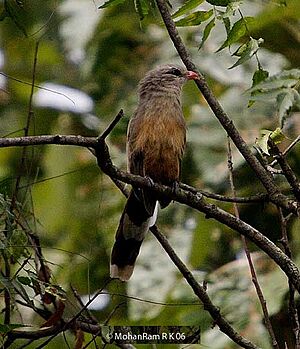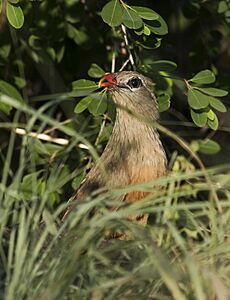Sirkeer malkoha facts for kids
Quick facts for kids Sirkeer malkoha |
|
|---|---|
 |
|
| T. l. leschenaultii (From Bangalore) | |
| Conservation status | |
| Scientific classification | |
| Genus: |
Taccocua
|
| Species: |
leschenaultii
|
| Subspecies | |
|
|
| Synonyms | |
|
|
The sirkeer malkoha or sirkeer cuckoo (Taccocua leschenaultii) is a special type of cuckoo bird. Unlike some cuckoos, it does not lay its eggs in other birds' nests. You can find this bird in dry forests and open woodlands across the Indian subcontinent.
This bird has a long tail and is mostly olive-brown on its back. It has a unique curved red beak with a yellow tip. Sirkeer malkohas usually look for food alone or in pairs. They often creep along the ground among grasses and bushes, especially in rocky areas. They eat small lizards, insects, and sometimes berries and seeds. These birds are very quiet, and male and female sirkeer malkohas look exactly alike.
What Does the Sirkeer Malkoha Look Like?
The sirkeer cuckoo is about 42–44 centimetres (16+1⁄2–17+1⁄4 in) long. Its back, wings, and central tail feathers are dark olive-brown. Its belly is a reddish-brown color. Its wings and dark tail feathers have a slight green shine.
The feathers on its chest have dark lines, which look like streaks. Its tail feathers get shorter towards the outside and have wide white tips. The feathers covering the top of its tail are long. Its chin, throat, and chest are light-colored.
The most noticeable part is its curved red beak with a yellow tip. Around its eyes, it has short, curved bristles that look like eyelashes. These help protect its eyes when it moves through grass. Its eyes are reddish-brown. It also has a thin, pale white line above and below each eye. A dark patch of skin around the eye makes it look bigger. Its legs are grey.
These birds have special feet called zygodactyle feet. This means two toes point forward and two point backward. This helps them grip branches and move on the ground. They search for food on the ground, on rocks, or among plants in thin forests. They usually live below 1500 meters (about 4900 feet) above sea level.
They eat caterpillars, insects, and other small creatures without backbones. They also eat small animals with backbones, berries, and seeds. If they feel threatened, they will sneak through thick bushes and run on the ground. They can look a bit like a mongoose when they do this. They are not strong flyers.
Sirkeer malkohas are usually very quiet. But they can make a low buzzing sound, like zwik. They also make sharp, repeated sounds like kik or kek. These sounds are similar to the calls of a rose-ringed parakeet.
There are different types, or subspecies, of the sirkeer malkoha. The ones in northwestern India are paler and have yellowish throats and chests. Birds in the Eastern Himalayas are darker and larger. The most common type is found across central and southern India and in Sri Lanka.
The scientific name Taccocua comes from French words for lizard cuckoos and another bird called Coua. The species name leschenaultii honors a French botanist named Jean Baptiste Leschenault de la Tour. The name sirkeer might come from a local name for the bird in Gujarat, India. Some people also call it junglee tota, which means 'jungle parrot', because its beak looks like a parrot's.
Where Do Sirkeer Malkohas Live?
Sirkeer malkohas live across the Indian subcontinent, including Bangladesh and Sri Lanka. You can also find them in some parts of Pakistan and Rajasthan. They are thought to have spread into the Sind region in the 1930s. This happened after a dam was built and more areas were irrigated with canals.
There are three main types of sirkeer malkohas. They differ slightly in color, but their living areas blend into each other.
Reproduction and Life Cycle
This cuckoo, like other malkohas, builds its own nest and raises its own young. It does not lay eggs in other birds' nests. The breeding season for these birds is usually from March to August.
During courtship, pairs of sirkeer malkohas bow to each other. They spread their tails wide like an open fan and hold them upright. They also puff out their feathers. After bowing, they raise their heads high and point their beaks upwards for a few seconds. They keep their beaks open during this display and make clicking sounds.
Their nest is shaped like a wide saucer. It is made of twigs and lined with green leaves. They usually place their nests in a low bush or tree. A female sirkeer malkoha lays two to three eggs. The eggs are pale yellowish-brown and have a shiny surface that disappears if washed. Both the male and female birds help to incubate the eggs. The exact time it takes for the eggs to hatch is not known.





